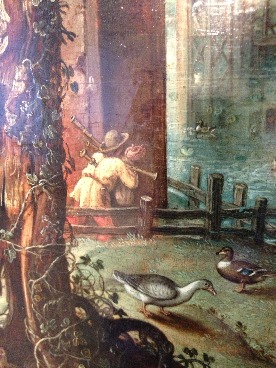The Bagpipe Society
Grace Notes

The months and years seem to swing by in an instant (is this me getting old?) and I’m writing this with less than a month to go before the Blowout but my mind is already racing ahead to my annual pilgrimage to Le Son Continu. 2018 marks the 30th anniversary of my first attending the festival. Back in 1988 my exposure to bagpipes had been fairly limited and mainly consisted of the Scottish, Irish and Northumbrian varieties and, through listening to David Munrow recordings, I had some awareness of medieval and renaissance bagpipes. Other than that I was quite ignorant of the world of bagpipes. In this respect my knowledge back then was no different to what the majority of people know of bagpipes today. I still get asked the name of the instrument I’m playing (and I know I’m not alone in this) and in my heritage job for the National Trust I continue explain to amazed audiences about the importance and prevalence of the bagpipe in the past.
The promotion of bagpipes through initiatives like International Bagpipe Day are, I believe, having a positive impact on increasing awareness and bagpipes are certainly more prevalent now than they were 30 years ago. But there is still a long way to go as, sadly, it is still seen by some as an instrument of ridicule or prejudice. I was amazed when a short clip of me playing bagpipes on IBD day this year went viral on Facebook and has now notched up 19,000 views and 377 shares!! Whilst there were a few disparaging comments (“bagpipes sound like a cat being boiled alive”) I can only hope that it was shared because people liked the clip or were intrigued by it and that now there are a few more who know that something other than the GHB exists! I shall soldier on spreading the word.
Eco-Friendly Society – Part One

By the time you receive this edition of Chanter, the chances are that the 2018 Blowout will have come and gone – and so will the various barrels of beer imported for the occasion! The Bagpipe Society has decided to do its bit for the environment and replace the throwaway plastic beer beakers usually on offer at the Blowout with lovely, bespoke, fully recyclable Eco-Cups. When this photo was posted on Facebook, we received an overwhelming positive response to them. Sadly, we cannot post them out as the costs of packing and handling them would far outweigh their value – but they will be for sale at next year’s Blowout! Exceptions to this rule may be made in exceptional circumstances – see below.
Eco-Friendly Society – Part Two
I’m often asked about the blue plastic envelopes that Chanter is posted out in. They were introduced after a disastrous mailing when over half the Chanters didn’t get to their rightful owners due to defective glue in the envelopes. (It was my third edition of Chanter and I very nearly chucked the job in after that one!). The blue envelopes are pretty secure and keep Chanter well and truly tucked in until opened by the recipient but I’m also pleased to tell you that the supplier has assured me that they are made from recycled plastic. Which means, of course, that the bag can be recycled again. So eco-credentials are assured!
Caption Competition winner!

Well, I can’t say I was overwhelmed by entries for the caption competition which appeared on the back cover of the Spring Chanter – in fact, I got a grand total of three! So, I’m therefore printing each and every one. I declare Kevin Carr the winner – and the decision was made on the basis that it aroused an immediate groan when tested on an unwitting friend. In view of the small field, all entrants will win a prize – an Eco-Cup each.
" Ha ha, you missed the bag!" – Kevin Carr Winner
`The perfect gift for the piper whose playing is best described as Bollocks’ – John Tose (best appreciated by those that know that the name of the knife stuck in the piper’s back is called a “bollock dagger”.
‘Is that a duck or are my drone reeds playing up again?’ Francis Wood.
Responses:
Hi Jane,
It was good to see that Ramblin’ Syd Rumpo is alive and well and has a new moniker: Julian Goodacre. His interesting use of looming pins and cordwangling techniques reminds me of one of Syd’s more printable songs where the great man implores us to “keep your hands off others’ moulies, ‘cos it is against the law”.
It would be interesting to know whether Julian has a good clean set of moulies. I am sure that those slightly mad Maltese zaqq pipers use them especially for tuning their rommelpots.
Best wishes, John Henry
Hi Jane
Regarding your piece about the “fontanelles” on bagpipes: Just a long shot here, but I have a set of hummelchen made by Toru Sonoda and there are sliders on all three drones and chanter. Now I have been neglecting them of late I have to say in favour of my Hungarian dudas so I can’t remember the technicalities of it all but they slide sideways so covering or uncovering a hole underneath which enables the retuning of the drones. Maybe this is too sophisticated a system to have been employed all those hundreds of years ago but it is a hypothesis worth considering.
I would add that on one of my sets of Bulgarian Kaba Gaida there is a section that can be added to the drone section when changing the chanter for another key. This brings the drone in tune with the new chanter.
What are your thoughts?
Regards, Mike Billington
Dear Jane,
Regarding your ideas about the function of “fontanelles” on drones, if they were removable in order to raise the pitch it would be so, so easy to lose them. How about if they could be rotated to uncover a hole to achieve the same result? A conventional tuning slide can change a drone note a small interval, but a tuning ring could potentially raise it any desired interval, e.g. a fourth, from the six-finger to the three-finger key, or even an octave to give a G g combination instead of G G.
I have a tuning ring on Sean’s Flemish set to raise my C baritone D, and on Julian’s renaissance pipes I can pull out the baritone from D to C. However, a greater interval would be useful at times, particularly for modal pieces.
Regards, Alan Radford
Dear Jane,
In his comments on my article ‘Lincolnshire, Lancashire and Scotch Bagpipes” (Chanter, Winter 2017/Spring 2018) John Peel queries my interpretation of the Eglantine bagpipe as a double-chanter instrument, seeing it as a single chanter with a single drone. This is indeed what I had always presumed myself, until I began writing the article and started to look at the image more closely.
If the second pipe is indeed a drone it is very unusual, for a British bagpipe at least, in being mounted in a separate stock parallel to the chanter. It was whilst contemplating the oddity of this arrangement that two things struck me: firstly, the “drone” is quite clearly tapered along its entire length, unlike both real-world drones and the vast majority of drone images. Secondly, although a considerable length is shown, there are no drone features at all - no tuning slides, ferrules, mounts, or turned decoration. Even the crudest imagery usually picks up on some of these features, and the Eglantine instruments are reasonably detailed. It was at this stage that it occurred to me that this was more likely to be a second chanter with the tone holes hidden because it is bent backwards and facing away from the viewer.
It’s worth mentioning that some of the more compelling double-chanter images in English churches may also show a double-stock arrangement (e.g. Altarnun and Broad Chalke).
Of course, ultimately this cannot be proved either way which is why I used the qualification “probably” – there isn’t a lot of certainty in the study of historic bagpipes! But the double-chanter interpretation seems to me to fit the available facts best. I think we may have all been seeing a drone because that’s what we expected to see.
Unfortunately, there was no space to discuss the issue properly in the Chanter article, which was really no more than a summary of a considerably longer piece, as yet unpublished, where these points are discussed at more length.
P.S. I’d like to thank John for the interesting additional material, especially for the Hedon Fair ballad, now added to my growing list of references to bagpipes in 18th century England! (from various internal references - especially to “macaronies” - I think the song probably dates to around the 1760s/70s.)
Bagpipe Passion
by p.j.sherman
I find the whole concept of sharing breath with the bagpipe to be very intimate. The bagpipe, in my mind, can be seen symbolically as another living creature, as you breathe life into it. It is like a meeting of lovers.
You take her
into your arms
and caress her tenderly,
and share your body warmth.
Then your lips connect and you
share your very breath. She warms
to your touch and breath, and two begin
to breathe as one, as your encircling arms
embrace and tighten lovingly. From this intimate
contact, a rhythm emerges - a squeezing, breathing,
pulsing alternation between tightening, forcing, giving moments
and relaxing, receptive, intuitive moments, as you instinctively
respond to make small adjustments to enhance the beauty of the moment.
From this union, a song emerges to express and release a wellspring of emotion.
This is followed by a return to silence,
peace and a sense of accomplishment,
and well-being. Passion spent,
emotions sated, silence rolls
over the scene like
a gentle wave.
The union dissolves and you become two again,
until the need wells up for another song,
and you reach out for the other once again.
The above composition was written about a year after I had received my first bagpipe. It was a Leicestershire windblown smallpipe by Julian Goodacre, and I bonded with it straight off. I found playing this soft-spoken wee pipe to be an intimate experience as the melody and my thoughts melded into the drone.
It was the beginning, and I have gone on to play and own many different pipes from different countries, keys, time periods, and with varying number of drones. Some are shrill, while some are just plain loud. I have some that employ a bellows, which eliminates a lot of reed problems, but for me, are more mechanical and much less intimate than sharing one’s own warm breath to bring the instrument alive. I enjoy all of my pipes, but like past lovers, there is always a special warm place in the memory for one’s first love. Thank you Julian for the pleasure that you have given me.
By Billington, Mike Henry, John Moulder, Jane Radford, Alan Sherman, P. J. Various Wood, Francis
From Chanter Summer 2018.
- Data Processing Notice (GDPR)
-
@BagpipeSociety on X (formally known as Twitter)
-
TheBagpipeSociety on Instagram
-
 BagpipeSociety on Facebook
BagpipeSociety on Facebook
Something wrong or missing from this page? Let us know!
